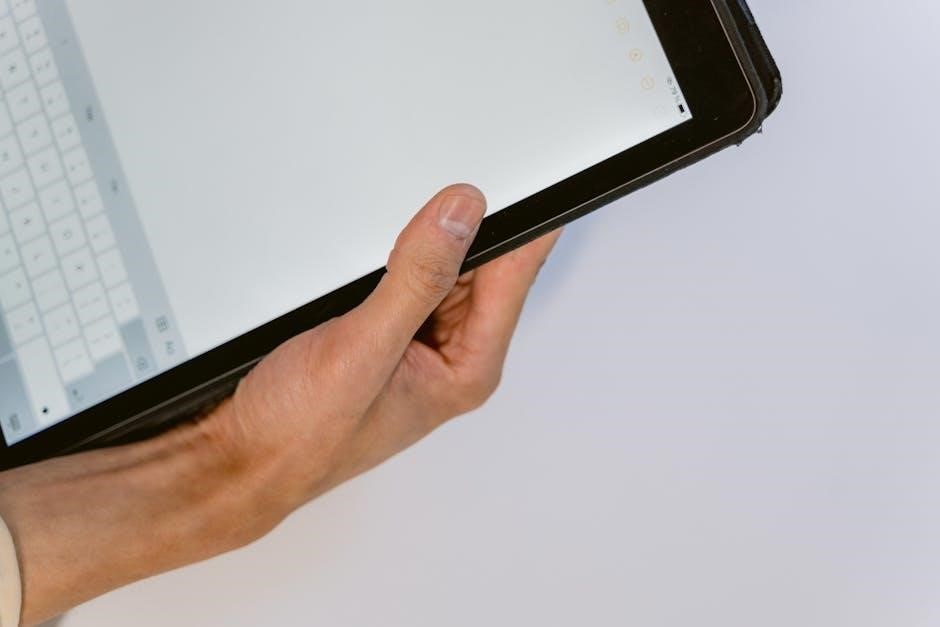mitel 5320e ip phone user guide

The Mitel 5320e IP Phone is a full-feature, dual-port enterprise-class device designed for voice communication over IP networks. It offers a 160×320 pixel display, programmable buttons, and wideband audio for enhanced call quality. Part of the 5300 series, it supports advanced features like on-hook dialing and a Ring/Message Indicator, making it ideal for business environments. This guide provides comprehensive insights into its functionality, customization, and troubleshooting.
1.1 Overview of the Mitel 5320e IP Phone
The Mitel 5320e IP Phone is a dual-port, enterprise-class device designed for voice communication over IP networks. Featuring a 160×320 pixel display and self-labeling programmable buttons, it supports wideband audio for superior call quality. Compatible with the Mitel 5000 Communications Platform, this phone offers advanced features like on-hook dialing and a Ring/Message Indicator. Its sleek design and intuitive interface make it ideal for business environments, providing users with a reliable and feature-rich communication tool.
1.2 Key Features of the Mitel 5320e
The Mitel 5320e IP Phone boasts a range of advanced features, including a 160×320 pixel graphical display, wideband audio for crystal-clear voice quality, and 11 programmable buttons for customization. It supports dual-mode operation, allowing seamless switching between IP and traditional voice networks. Additional features include a built-in speakerphone, Ring/Message Indicator, and compatibility with the Mitel 5000 Communications Platform. These features ensure a flexible, efficient, and high-quality communication experience tailored to meet the demands of modern business environments.

Getting Started with the Mitel 5320e IP Phone
Getting started with the Mitel 5320e IP Phone is straightforward. Begin by unboxing and physically setting up the device, then connect it to your network. Follow the initial configuration steps to activate and customize your phone for optimal use.
2.1 Unboxing and Physical Setup
When unboxing the Mitel 5320e IP Phone, ensure all components are included, such as the handset, base unit, and accessories like the Ethernet cable and power adapter. Begin by placing the phone on a flat surface or mount it on the wall using the provided hardware. Connect the Ethernet cable to the appropriate port for network access and ensure the power supply is properly connected. Carefully attach the handset to the base unit and verify that all buttons and features are accessible. Properly positioning the phone ensures optimal functionality and user experience.
2.2 Connecting the Phone to the Network
To connect the Mitel 5320e IP Phone to the network, first, locate the Ethernet port on the base unit. Insert one end of the Ethernet cable into the phone’s port and connect the other end to a nearby network switch or router. Ensure the phone is powered on using the provided power adapter or through Power over Ethernet (PoE) if supported by your network. Once connected, the phone will automatically detect and configure the network settings. Use the navigation buttons to verify the connection status on the display. Proper network connectivity is essential for optimal performance and feature functionality.
2.3 Initial Configuration and Setup
After connecting the phone to the network, power it on; The phone will display the Mitel logo and perform a self-test. Once complete, select your network from the available options. Configuration options include DHCP or static IP setup. Enter network credentials if required. Administrator access may be needed for advanced settings. Follow on-screen prompts to set up voicemail by pressing the Messages button and following voice prompts. Review and save all settings to ensure proper functionality. This initial setup ensures the phone is ready for use on your network.

Understanding the Phone Layout
The Mitel 5320e IP Phone features a 160×320 pixel display, programmable buttons, fixed buttons, and a dial pad. The layout includes a handset, speakerphone, and navigation controls for intuitive operation.
3.1 Display and Navigation
The Mitel 5320e IP Phone features a 160×320 pixel backlit LCD display, providing clear visibility of call details, menus, and status indicators. Navigation is facilitated by directional keys (up, down, left, right, and OK) and a menu button for easy access to phone functions. The display also shows programmable button labels, ensuring users can quickly identify features. Additional fixed buttons like Home and Back simplify menu navigation. Together, these elements create an intuitive interface for managing calls, settings, and advanced features efficiently.
3.2 Fixed and Programmable Buttons
The Mitel 5320e IP Phone includes a combination of fixed and programmable buttons for enhanced functionality. Fixed buttons such as Home, Back, Speaker, and Mute provide quick access to essential features. Programmable buttons can be customized to suit individual preferences, allowing users to assign functions like speed dial, call forwarding, or feature codes. These buttons are self-labeling, ensuring clarity and ease of use. The programmable keys can be configured through the Mitel Web Configuration Tool, offering flexibility and personalization for users. This feature-rich design ensures efficient communication and streamlined workflows.
3.3 Handset and Speakerphone
The Mitel 5320e IP Phone features a comfortable handset and a high-quality speakerphone for clear voice communication. The handset provides traditional phone functionality, while the speakerphone enables hands-free conversations. The speakerphone supports wideband audio, delivering crisp and natural sound. Users can easily switch between the handset and speakerphone during calls, ensuring flexibility. The phone also includes noise reduction technology to enhance audio clarity, making it ideal for conference calls or collaborative environments. These features ensure a seamless and professional communication experience.
3.4 Dial Pad and Soft Keys
The Mitel 5320e IP Phone features a standard dial pad with backlighting for easy visibility. The dial pad allows users to enter phone numbers, feature codes, and text input for various functions. Soft keys located below the display provide dynamic, context-sensitive options, such as call handling, messaging, and directory access. These keys change depending on the phone’s state, offering intuitive navigation. Additionally, the navigation cluster enables scrolling through menus and selecting options efficiently, enhancing overall usability and user experience.

Basic Call Functions
The Mitel 5320e IP Phone supports essential call functions like making and answering calls, placing calls on hold, transferring, and setting up conferences. The dial pad and soft keys simplify call handling, while navigation buttons provide easy access to menus and features.
4.1 Making a Call
To make a call on the Mitel 5320e IP Phone, lift the handset or press the Speaker button. Use the dial pad to enter the desired phone number. Press the soft key labeled “Dial” or “Call” to initiate the call. For hands-free conversations, the speakerphone can be activated before or during the call. The phone also supports speed dialing for frequently called numbers, streamlining the process. Additionally, call logs can be accessed to redial recent numbers, enhancing efficiency and ease of use.
4.2 Answering a Call
To answer an incoming call on the Mitel 5320e IP Phone, lift the handset or press the Speaker button to activate the speakerphone. You can also use a headset if connected. The phone will ring and display the caller’s information. If the phone is idle, pressing any programmable button or the Dial Pad will also answer the call. Additionally, you can use the “Answer” soft key to accept the call. The Ring/Message Indicator will flash to alert you of an incoming call, ensuring you never miss important connections.
4.3 Placing a Call on Hold
To place a call on hold on the Mitel 5320e IP Phone, press the Hold soft key or the Hold button during an active call. The caller will hear hold music or tones, and the phone’s display will indicate the call is on hold. The Ring/Message Indicator may flash to show a held call. To retrieve the call, press the Hold button again or use the Resume soft key. This feature allows you to manage calls efficiently while handling other tasks or waiting for additional information.
4.4 Transferring a Call
To transfer a call on the Mitel 5320e IP Phone, press the Transfer button during an active call. Dial the recipient’s extension or phone number using the dial pad. For an attended transfer, wait for the recipient to answer, communicate briefly, then press Transfer or Send to complete. For a blind transfer, press Transfer immediately after dialing. The call will be redirected without waiting for the recipient to answer. Use programmable buttons if preconfigured for one-touch transfers. The display will confirm the transfer, and the call will be moved to the selected extension.
4.5 Conferencing and Multi-Party Calls
To initiate a conference call on the Mitel 5320e IP Phone, press the Conference button during an active call. Dial the additional participant’s number or extension using the dial pad. Once connected, press Conference again to merge the calls into a multi-party conference. For additional participants, press Conference to split the call, dial the new number, and press Conference to merge them into the main call. Use feature code *94 to start a new conference. The phone supports up to 32 participants. Press End Call to terminate the conference.

Advanced Call Features
This section covers advanced call management features like call forwarding, do not disturb, and call parking. It enhances communication efficiency and user experience with customizable settings.
5.1 Call Forwarding and Do Not Disturb
Call Forwarding allows users to redirect incoming calls to another number or voicemail. Do Not Disturb mode silences the phone, sending calls directly to voicemail. Both features enhance productivity by minimizing interruptions. To activate Call Forwarding, use the feature code or navigate through the phone menu. Do Not Disturb can be toggled via the phone’s interface or programmed on a programmable button. These features ensure calls are managed efficiently, reducing distractions and improving focus during critical tasks. They are essential for balancing availability and concentration in a busy work environment.
5.2 Call Parking and Retrieval
Call Parking allows users to place a call on hold in a virtual parking spot, enabling retrieval from another phone. To park a call, press the Park soft key or use the feature code. The system assigns a parking spot number, which can be used to retrieve the call from any phone. Call Retrieval is done by dialing the parking spot number. This feature is useful for transferring calls between team members or handling calls in different locations without disconnecting the caller. It enhances collaboration and ensures calls are managed efficiently.
5.3 Voicemail and Message Waiting Indicators
The Mitel 5320e IP Phone supports voicemail and message waiting indicators to keep users informed. The Ring/Message Indicator flashes to signal new voicemail. Access voicemail by pressing the Messages soft key or using the feature code. Users can customize greetings and manage messages directly from the phone. The system also provides visual alerts for unread messages, ensuring users never miss important communications. This feature enhances productivity by streamlining message management and maintaining clear communication channels.
5.4 Speed Dial and Directory Access
The Mitel 5320e IP Phone simplifies communication with speed dial and directory access features. Users can program frequently called numbers to programmable buttons for quick access. The directory feature allows browsing through system contacts, ensuring efficient communication. Calls can be initiated directly from the directory, streamlining workflows. Additionally, the phone supports synchronization with system directories, updating contacts automatically. These features enhance productivity by reducing dialing time and providing easy access to essential contacts, making communication faster and more efficient for users.

Voice Messaging and Voicemail
The Mitel 5320e IP Phone supports advanced voicemail and messaging features, including message waiting indicators and customizable greetings. Users can access and manage voicemail messages efficiently.
6.1 Setting Up Voicemail
Setting up voicemail on the Mitel 5320e IP Phone allows users to manage messages efficiently. Start by accessing the voicemail menu through the phone’s interface or dialing the designated feature code. Follow the prompts to create a PIN and record a greeting. Ensure the message waiting indicator is enabled to receive visual notifications. Refer to the user guide for detailed steps on configuring voicemail settings and customizing greetings. System administrators can also configure voicemail options through the Mitel Web Configuration Tool for centralized management.
6.2 Accessing and Managing Voicemail Messages
To access voicemail on the Mitel 5320e IP Phone, press the Messages button or dial the voicemail access code. Navigate through the menu to listen to, delete, or save messages. Use the soft keys to manage messages, such as skipping, repeating, or forwarding. Deleted messages are moved to a purge box for permanent deletion. Ensure the message waiting indicator is enabled to receive notifications. For detailed steps, refer to the user guide or contact your system administrator for assistance with customization or troubleshooting;
6.3 Customizing Voicemail Greetings
Customizing voicemail greetings on the Mitel 5320e IP Phone allows you to personalize your messages for callers. Access the voicemail system by pressing the Messages button or dialing the assigned code. Navigate to the Greetings menu, typically found under Voicemail Settings or Admin Options. Record your desired greeting using the phone’s interface or a connected device. Save the greeting and set it as active to ensure callers hear your personalized message. For multiple greetings or advanced options, consult the user guide or contact your administrator for assistance.
6.4 Voicemail Notification Options
The Mitel 5320e IP Phone offers customizable voicemail notification options to keep you informed. Enable visual alerts, such as a flashing Ring/Message Indicator or on-screen notifications, to stay updated on new messages. Audio alerts can also be configured for audible notifications. Additionally, you can set up email notifications to receive alerts when a new voicemail is received. These settings can be customized through the phone’s voicemail menu or via the Mitel MiVoice Business platform. Refer to the user guide for detailed steps on configuring these options to suit your preferences.

Customization and Personalization
The Mitel 5320e IP Phone allows users to customize their experience with programmable buttons, personalized ring tones, and adjustable display settings for enhanced productivity and comfort.
7.1 Customizing the Phone Display
The Mitel 5320e IP Phone offers a customizable 160×320 pixel display, allowing users to personalize wallpapers, adjust brightness, and modify screen savers. The display’s contrast and backlight settings can also be tailored for optimal viewing comfort. Additionally, users can customize the idle screen with company logos or personal images, enhancing the visual experience. These features ensure the phone’s interface aligns with individual preferences, providing a seamless and user-friendly experience.
7.2 Programming Programmable Buttons
The Mitel 5320e IP Phone features programmable buttons that can be customized to suit individual or organizational needs. These buttons can be assigned functions like speed dial, call forwarding, or feature codes, enhancing workflow efficiency. Users can program the buttons using the Mitel Web Configuration Tool or directly through the phone’s interface. This customization allows for quick access to frequently used features, streamlining communication and improving productivity. Programmable buttons also support labels, making it easy to identify their assigned functions at a glance.
7.3 Setting Up Ring Tones and Alerts
The Mitel 5320e IP Phone allows users to customize ring tones and alerts to personalize their experience. Through the Mitel Web Configuration Tool or the phone’s menu, users can select from predefined tones or upload custom ring tones. Alerts can be configured to notify users of specific events, such as voicemail notifications or incoming calls from particular contacts. This feature enhances user experience by providing auditory cues tailored to individual preferences, ensuring important communications are never missed;
7.4 Language and Localization Settings
The Mitel 5320e IP Phone supports multiple languages, including English, Spanish, French, and more, allowing users to customize the interface to their preference. To change the language, navigate to the phone’s settings menu and select the desired language from the available options. Additionally, localization settings enable users to configure date, time, and dialing formats according to regional standards. The phone also supports right-to-left languages, ensuring accessibility for a diverse user base. These settings can be adjusted manually or managed by system administrators to align with organizational requirements.

Network and Connectivity
The Mitel 5320e IP Phone operates on IP networks, requiring a stable connection for optimal performance. It supports network configurations, ensuring reliable voice communication and scalability in enterprise environments.
8.1 Network Requirements for the Mitel 5320e
The Mitel 5320e IP Phone requires a stable IP network connection for optimal functionality. It supports Power over Ethernet (PoE) or an optional local power supply. The phone is compatible with VLAN tagging and Quality of Service (QoS) to ensure prioritized voice traffic. A minimum network speed of 100 Mbps is recommended for smooth operation. Security features include HTTPS for secure configuration updates and firmware patches. Proper network configuration ensures reliable voice communication and supports advanced call features.
8.2 Configuring Network Settings
Configuring network settings for the Mitel 5320e IP Phone involves accessing the device’s web interface. Users can assign static IP addresses or enable DHCP for dynamic IP assignment. VLAN tagging and Quality of Service (QoS) settings can be configured to prioritize voice traffic. Ensure HTTPS is enabled for secure configuration updates. The phone supports dual-port connectivity, allowing for primary and secondary network connections. Properly configure subnet masks, gateways, and DNS settings for optimal network performance. Verify all settings to ensure seamless integration with your enterprise network environment.
8.3 Troubleshooting Network Connectivity Issues
Troubleshooting network connectivity issues on the Mitel 5320e IP Phone involves checking physical connections, ensuring the phone is powered on, and verifying network settings. Test cable connections and port configurations. Restart the phone if it fails to register with the network. Check for firmware updates and ensure the device is running the latest version. Use the phone’s web interface to review diagnostic logs and test network connectivity. If issues persist, inspect VLAN settings, DNS configurations, and IP address assignments to ensure they align with your network environment.

Security Features
The Mitel 5320e IP Phone offers robust security features, including password protection, secure HTTPS configuration, and regular firmware updates to ensure network and call security.
9.1 Securing the Phone with a Password
Securing the Mitel 5320e IP Phone with a password ensures unauthorized access is prevented. To set up password protection, navigate to the phone’s admin menu and select Security Settings. Create a strong password and confirm it to enable this feature. This protects the phone’s configuration and prevents unauthorized changes. Regularly updating the password is recommended for enhanced security. Password protection is essential for maintaining privacy and preventing tampering with phone settings. Always use a secure password to safeguard your device and data. This feature is a critical part of maintaining overall system security.
9.2 Enable HTTPS for Secure Configuration
Enabling HTTPS on the Mitel 5320e IP Phone ensures secure communication during configuration updates. To activate HTTPS, access the phone’s web interface through its IP address using a browser. Navigate to the Security or Advanced Settings menu and select the HTTPS option. This encrypts data transfers, protecting sensitive information. Regularly updating firmware via HTTPS ensures security patches are applied securely. Consult the Mitel 5320e user guide for detailed steps. This feature is vital for maintaining data integrity and preventing unauthorized access during configuration processes.
9.3 Firmware Updates and Security Patches
Regular firmware updates and security patches are essential for maintaining the Mitel 5320e IP Phone’s performance and security. Updates often include feature enhancements, bug fixes, and vulnerability patches. To update, access the phone’s web interface, navigate to the Administration or Maintenance section, and upload the latest firmware from Mitel’s official website. Ensure the phone is connected to the network and powered on during the process. Security patches protect against potential exploits and ensure compliance with enterprise security standards. Always verify firmware authenticity to prevent unauthorized modifications.

Maintenance and Troubleshooting
Regularly clean the phone to maintain functionality. Check for firmware updates to ensure optimal performance. Reset to factory settings if issues persist. Troubleshoot connectivity problems promptly.
10.1 Regular Maintenance Tasks
Regular maintenance ensures optimal performance of the Mitel 5320e IP Phone. Clean the display and keypad with a soft cloth to prevent dust buildup. Check for firmware updates and install the latest version to enhance security and functionality. Inspect the handset and speaker for debris and wipe them with a damp cloth. Power cycle the phone monthly to reset internal components. Verify network cable connections are secure, and test audio quality periodically. Schedule these tasks to maintain reliability and ensure uninterrupted communication.
10.2 Common Issues and Solutions
Common issues with the Mitel 5320e IP Phone include connectivity problems, audio distortion, and firmware glitches. For connectivity, ensure cables are securely connected and network settings are correct. Restart the phone if it fails to register with the server. Audio issues can often be resolved by cleaning the handset or speaker. For firmware-related problems, install the latest updates or reset the phone to factory settings. Consult the user guide or contact support for persistent issues to ensure optimal functionality and performance.
10.3 Resetting the Phone to Factory Settings
To reset the Mitel 5320e IP Phone to factory settings, navigate to the phone’s admin menu, select “Reset to Defaults,” and enter the admin password. This process restores the phone to its original configuration, erasing all custom settings. Ensure all critical configurations are backed up before proceeding. If issues persist after the reset, consult the user guide or contact your system administrator for further assistance. This step is ideal for resolving persistent firmware or configuration-related problems.
10.4 Best Practices for Optimal Performance
Regularly update the phone’s firmware to ensure the latest security patches and feature enhancements. Maintain a stable network connection by configuring Quality of Service (QoS) settings. Organize programmable buttons to streamline workflows. Schedule periodic backups of custom settings to prevent data loss. Clean the display and keypad regularly to avoid dust buildup. For advanced configurations, consult the user guide or contact your system administrator. Addressing these practices ensures the Mitel 5320e operates efficiently and reliably in your work environment.
The Mitel 5320e IP Phone combines efficiency, customization, and reliability, making it a robust solution for business communication. Its advanced features ensure seamless connectivity and enhanced productivity.
11.1 Summary of Key Features
The Mitel 5320e IP Phone is a feature-rich device designed for enterprise communication. It includes a 160×320 pixel display, programmable buttons for customization, and HD audio for clear calls. The phone supports dual-mode operation and integrates seamlessly with the Mitel 5000 Communications Platform. Additional features like call forwarding, voicemail, and advanced security options enhance user experience. Its sleek design and intuitive interface make it a reliable choice for businesses seeking efficient communication solutions.
11.2 Final Tips for Effective Use
For optimal use of the Mitel 5320e IP Phone, ensure regular firmware updates and restart the device periodically to maintain performance. Customize programmable buttons to streamline workflows and personalize settings like ring tones and language preferences. Familiarize yourself with the phone’s web interface for advanced configurations. Troubleshoot issues by checking network connectivity and consulting the user guide. Explore features like call forwarding and voicemail to enhance productivity. Experiment with programmable keys and voicemail settings to tailor the phone to your needs. Regularly review and update your settings for the best experience.